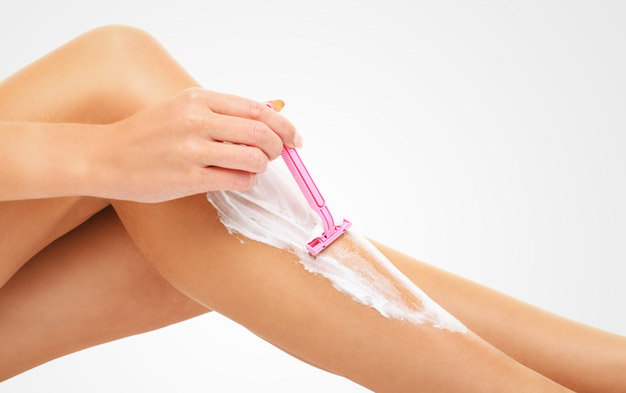Sometimes, the skin surrounding the ingrown hair may become noticeably darker. This is called hyperpigmentation. (Read our full resource page on hyperpigmentation for more details.) The area may also be painful or itchy. Our hairs are unique to each of us—the density, coarseness, colour, and regrowth rate varies for each individual. Anyone can develop ingrown hairs, but they can be more of a problem for those with coarse or curly hair.

The direction of growth and hair play have a role in ingrown hairs. A curved hair follicle, one which generates tightly curled hair, is believed to prompt the hair to grow back into the skin once the hair is cut and starts to grow back. Shaving cuts a sharp edge on this type of hair, particularly if the hair is dry during shaving. You can also get ingrown hairs if you:
Pull your skin tight during shaving: Which means the cut hair draws back into the skin and re-enters the follicle without growing out properly first.
Tweeze: Which can leave a fragment of hair underneath the skin surface.
When a hair remains in the follicle, your skin reacts like it’s a foreign body, so it becomes inflamed.
Ingrown hairs have typically usually grown out of the follicle, but not been able to exit the dermis layer, so they’ve curled around and stayed trapped – without even exiting the skin. Some hairs have exited and curled back into the skin. When follicles are clogged, the hair inside it is forced to grow sideways. This is even more likely to happen if the hair is particularly curly, coarse or recently plucked.
Ingrown hairs can be a major issue on the body in areas where people shave. In men, ingrown hairs commonly appear in the beard area, on the chin and cheeks and, typically, the neck. They can also appear on the scalp in those who shave their heads. For women, ingrown hairs appear on these areas: legs, armpits, and the bikini line.
Ingrown hairs look like pustules or pimples on the skin, and typically you can see the hair trapped in the spot which can be filled with pus. Usually, ingrown hairs can improve without treatment. It’s possible to avoid ingrown hairs by not removing hair in the first place. But for many of us, that’s not an option. In which case, there are hair removal methods that lessen the risk of ingrown hairs from developing.
Signs and symptoms of ingrown hairs include:
– Hard, little, rounded bumps (papules)
– Little, pus-filled, blister-like lesions (pustules)
– Pain
– Itching
– Embedded hairs
– Skin darkening (hyperpigmentation)
The odd ingrown hair is not a cause for alarm, but if you are experiencing chronic conditions then it’s possible to treat it with an experienced dermatologist.
A chronic condition of ingrown hairs can lead to:
– Bacterial infection (caused by scratching)
– Skin darkening (hyperpigmentation)
– Keloid or permanent scarring
– Pseudofolliculitis barbae, also called razor bumps

As well as choosing other hair removal methods, it’s possible to prevent ingrowing hairs. Always exfoliate and hydrate your hairs first, by gently scrubbing thhe area and soaking the area in lukewarm water for 3-5 minutes before removal. Exfoliate at least once or twice a week to get your skin into the best condition possible. This helps remove dead skin cells efficiently which in turn helps decrease the risk of ingrown hairs. Apply a moisturiser to keep skin supple and hydrated. During hair removal make sure you don’t apply too much pressure as this can also help encourage ingrown hairs.
At CoLaz we have two treatments which can dramatically help to diminish ingrown hairs:

Laser hair removal is the best solution for ingrown hairs, especially if you have coarse or curly hair. Laser treatments focus on directly destroying the hair follicles at the source and eliminates any hair fragments, so it doesn’t get a chance to become ingrown at all. Over time with laser hair removal, the hairs become lighter in density and thinner which also reduces the likelihood of this reoccurring. However, laser is not an overnight solution to this condition. Multiple sessions are required to decrease ingrown hairs and prevent them from forming in the first place.

Probably the best hair removal method for eliminating the risk, and even treating ingrown hair, is Electrolysis. Electrolysis is a treatment that involves removing hair permanently by eradicating the root at the hair follicle. This makes it a highly desirable procedure. The main reason Electrolysis is so popular because it has a proven track record of success. Electrolysis is a viable solution for all skin tones and hair types. Plus, it can be used on all areas of the body and will permanently stop the hair from regrowing.